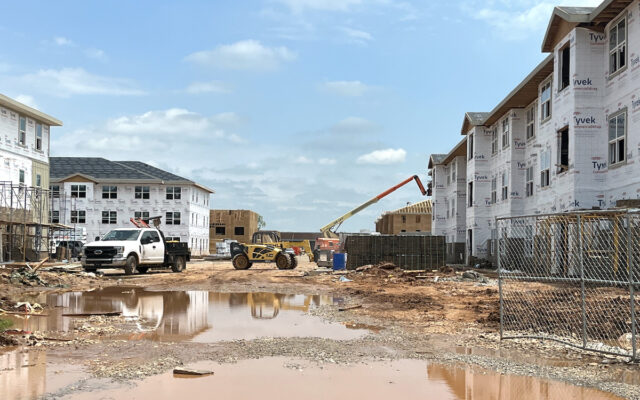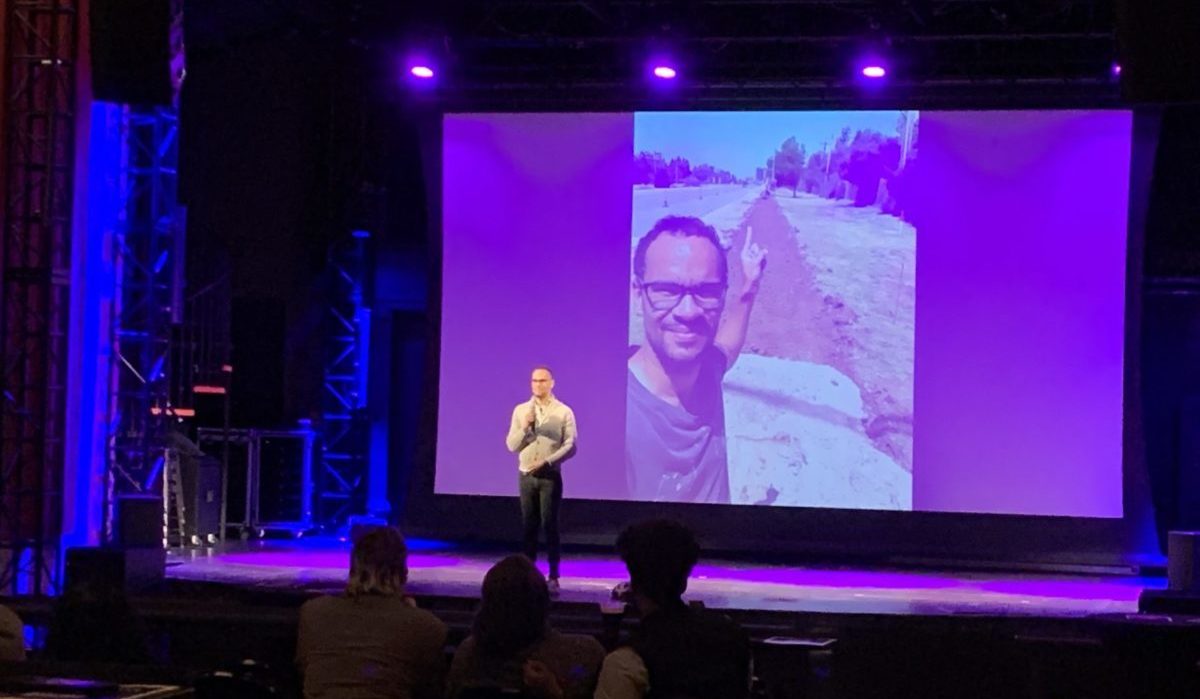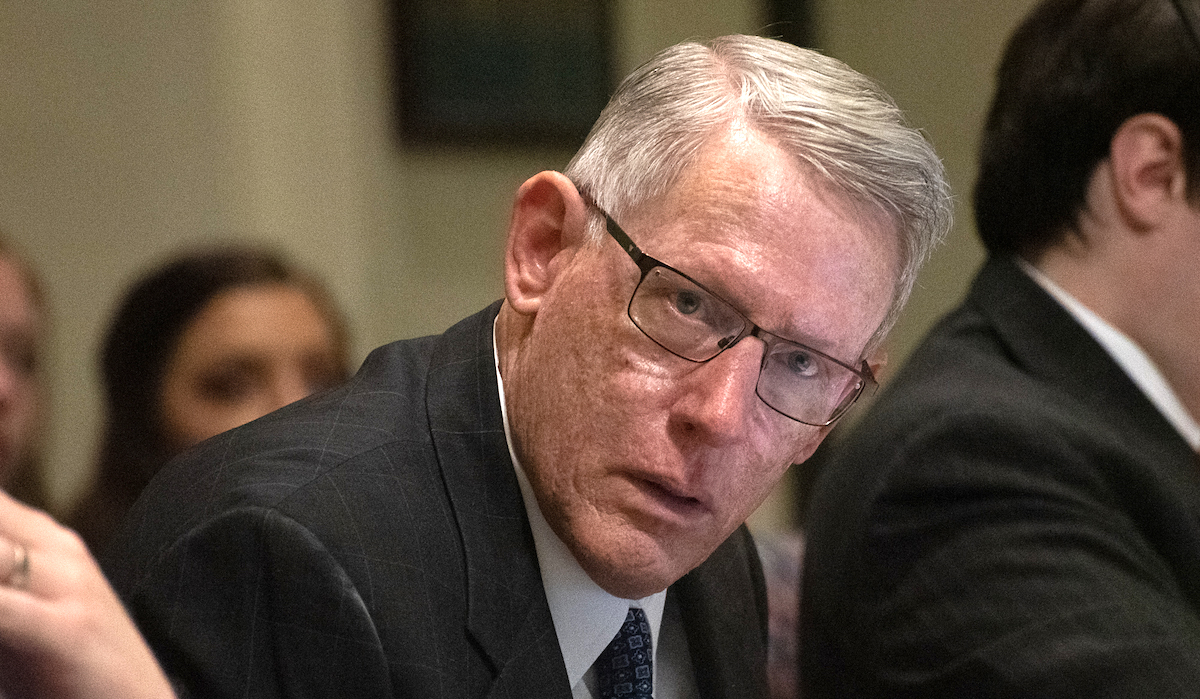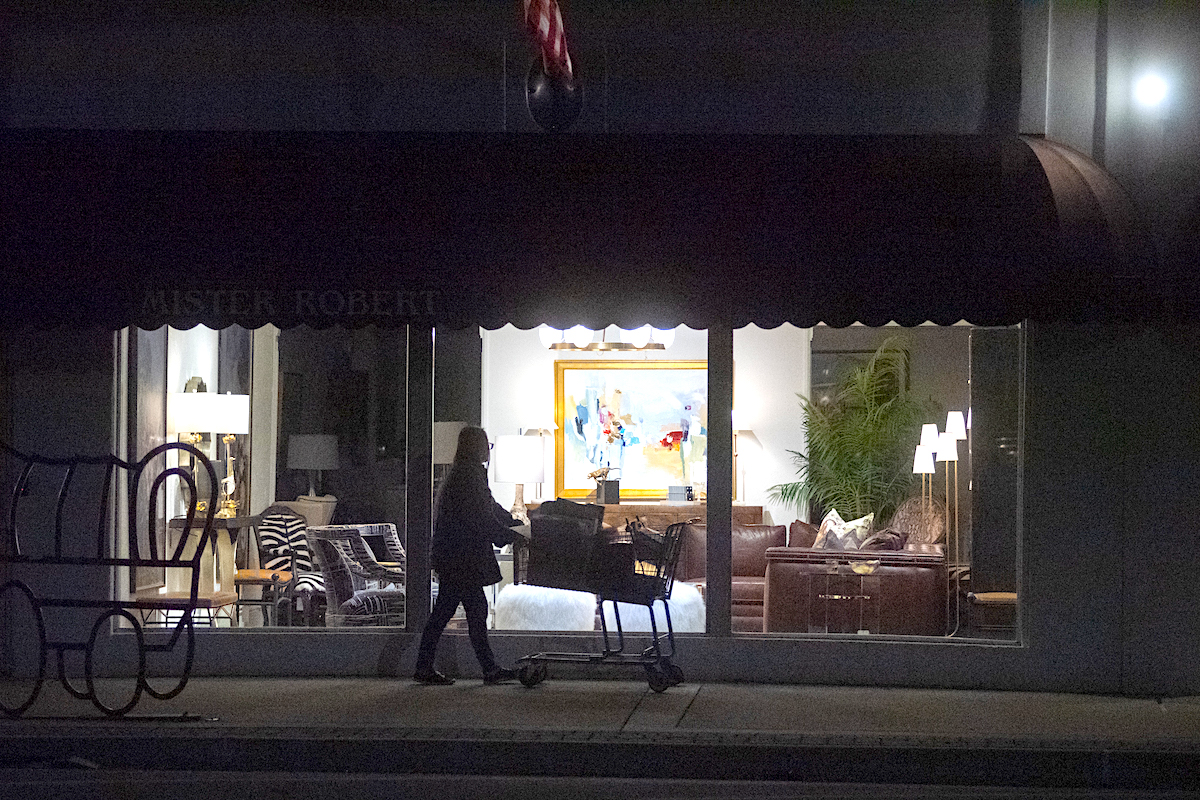
Jessica Ramirez spends her days caring for her 1-year-old son and working as a cashier, hoping to keep a roof over her head and her son fed and in diapers.
The money she makes is never enough. To make matters worse, the mobile home that Ramirez rents is falling apart, and her landlord has become another obstacle in a life full of them.
Ramirez moved to Oklahoma from California aiming for a fresh start, but little has worked out as planned. After her husband became incarcerated, Ramirez was on her own.
She told her landlord about what happened with her husband. Her husband’s name was removed from the lease, leaving her solely responsible for the rent. Ramirez had been given a sheet explaining the situation she was in and what her rights were at a local domestic violence shelter.
“He laughed,” Ramirez said of her landlord. “He didn’t take any of it seriously.”
Now, the mobile home is falling apart. The drains back up and mold grows in the living room and bathroom. The mobile home has several holes that she has fixed with Flex Seal.
“He came pounding on my door one day saying he was going to take us to court for unpaid rent and that he was going to evict us,” Ramirez said.
Ramirez had just recently started her cashier job and had yet to receive her first paycheck.
“It’s scary, because I don’t know where we would go if we got evicted,” she said. “Where would we sleep?”
Ramirez is far from alone in facing housing insecurity. Oklahoma County saw 17,868 evictions filed in 2023. There were 8,602 judgments resulting in eviction, according to data from Shelterwell.
During her time of turmoil, Ramirez has received help for her rent from Catholic Charities and Upward Transitions.
“I think one of the biggest problems is that in Oklahoma there aren’t as many programs available for people as there were in California, which has a lot more programs that can help with rent,” she said. “But even if you look at the help that’s out there, if people don’t know about it, they can’t get help.”
Follow @NonDocMedia on:
Facebook | X | Text or Email
OKC ‘getting ready to experience’ big-league challenges

Oklahoma City is a big-league city with a big-league basketball team and a soon-to-be brand new $900 million big-league arena funded primarily by taxpayers.
But the OKC metro also faces complicated big-league problems regarding affordable housing that are causing more people to become unhoused all around the country.
From 2000 to 2018, Oklahoma County was ranked No. 20 nationally in evictions with a rate of 6.19 percent over that period.
Things were even worse in Tulsa County, which checked in at No. 11 on the list with a 7.7 percent eviction rate over the nearly two-decade period tracked by Eviction Lab. (The onset of the pandemic two years later only made matters worse.)
In 2000, the median rent in Oklahoma County was $483 a month. By 2010, the monthly median rent jumped to $731 per month. By 2018, it stood at $851 per month.
Those looking to buy an affordable home are also facing an inventory crunch, as median home prices in Oklahoma County have been on an upward trend for more than a decade.
Speaking at an OKC Ward 2 town hall hosted by Councilman James Cooper on housing in November, Gary Jones, Oklahoma City Metro Association of Realtors government affairs director, delivered some hard truths in his address at a packed Tower Theatre.
“The reason that housing is so important is not because we need to live in one, but there is an actual framework that dictates how and what happens within housing,” Jones said. “And, unfortunately, because of the unprecedented growth that we’re experiencing in Oklahoma City, we’re getting ready to experience what San Francisco experienced, what Washington, D.C., experienced, what New York City experienced. I know somebody here says, ‘We don’t experience that in Oklahoma City.’ Well, you know what, they didn’t experience it either until they got the growth that they did.”
RELATED
Edmond, Norman, Shawnee face affordable housing and homelessness challenges by Joe Tomlinson
Jones said it has long been time for the state to do more to create affordable housing before the issue becomes an even bigger crisis. Last year, the Oklahoma Legislature listened and created the state’s new Housing Stability Program, which is aimed at providing development funding for affordable single and multi-unit family housing. The statewide program is now taking applications from builders, who can receive zero-interest loans to develop projects and increase the state’s housing supply. The loans must be repaid within two years to avoid interest charges.
“Affordable housing does not mean that you’re poor,” he said. “Affordable housing means that the income you make does not allow you to buy or to rent in the market that you live in. And people need to understand that.”
Cooper has been hearing concerns about rent and housing affordability from people in his ward for years. With about 1,400 people in Oklahoma City experiencing homelessness on any given night — and about 500 of them sleeping outside — the OKC City Council has taken some recent steps toward addressing the issue.
Last year, the OKC City Council voted to make $55 million available to the Oklahoma City Housing Authority to renovate and build affordable housing. All told, about $400 million from public and private funds that were part of the 2020 MAPS 4 package will also be used to add 1,500 housing units in the years to come. In February, the City of OKC received a $7.1 million grant from the U.S. Department of Housing and Urban Development to provide homes for those who are unhoused.
Some of the OKC’s programs are already bearing fruit. The city purchased an old Motel 6 east of Bricktown that will be converted into 75 studio apartments. The city’s Key to Home program is also well underway, housing about 90 of the most chronically homeless people in the city over the last year.
OKC Ward 6 Councilwoman JoBeth Hamon believes those programs are a step in the right direction but are unlikely to fully resolve the need for more affordable housing in the city.
“I think one of the things we’ve seen is the lack of a clear, long-term, coherent strategy,” she said. “What we’ve seen in the past is kind of uneven response to the problem of both homelessness and affordable housing, and what that’s led to are challenges for those who are either middle- or lower-income.”
As of 2024, Oklahoma City checks in as the 20th-largest city in the United States and ranks sixth nationally in growth, a fact that has become a regular talking point from OKC Mayor David Holt. OKC grew by about 102,000 people from 2010 to 2020, according to U.S. Census Bureau data. The growth continues at about 1 to 2 percent a year.
As a result, Cooper still worries the city may remain behind in the long game, even with some new housing efforts underway. Cooper sees an opportunity with urban infill, which involves developing small parcels of land in urban areas that have either been vacant lots or have held uninhabitable homes. Urban infill stands as an alternative to suburban sprawl, although OKC’s housing demand likely requires an “and” not an “or” approach moving forward.
“There is an opportunity with urban infill around the city,” Cooper said. “This is land that can be used to build affordable housing units for people, and they don’t have to be massive, complicated developments spread out all over the city. Utilizing space in that way makes more sense than continuously creating more sprawl.”
Cooper said the latter has been the city’s long-term direction.
“I’m 41, and as a government, the City of OKC for all of those 41 years has helped induce developers to gobble up farmland along the peripheral parts of the city so they could develop the land into these residential one- and two-story homes that, in a lot of parts of the city, are unaffordable,” Cooper said.
Cooper said at the same time that was happening, nothing was being done to encourage infill across the core of the city.
“Now we have to do that. We have no choice,” Cooper said. “We have to invest in the next bond at least 10 times the $10 million we did in the last bond, and I’m telling you that would be barely scraping by, in my opinion, (at) $100 million. We have to figure out how we incentivize our urbanist development community to build infill developments that are one- and two-bedroom, less than 1,000 square feet for people that need that.”
Cooper said about 19,400 Oklahoma City residents in need of housing units fit that bill, but he said there are only about 3,600 housing units available at any given time.
“That’s not capitalism,” Cooper said. “Capitalism is supply and demand, and right now the free market has been corrupted, and instead of meeting the demand with the supply, we let people play Pac-Man with farmland. What if you’re a teacher making $40,000 a year, where are you buying a house?”
Still, a variety of factors have combined to make even urban in-fill developments difficult. After growing between 0.4 percent and 4.8 percent a year from 2016 through 2020, building material prices climbed about 15 percent a year in both 2021 and 2022.
As a result, the capital outlay now required to build a duplex on a small lot often necessitates rent beyond the definition of “affordable” and far beyond the parameters of Section 8 housing vouchers, which help low-income individuals with rent.
The conundrum caused state leaders to create the subsidization programs for new housing construction last year. But as those efforts take aim at the “workforce housing” supply side of the problem, other market factors — such as stagnant wages, overall inflation and limited access to mental health and other support services — have left more people with a tenuous grasp on their housing security.
Housing instability fuels other problems

A community’s lack of affordable housing puts more people at risk of becoming unhoused, and for many the margins are thin. A lost job, a broken car, a sick loved one: Even a small crisis can touch off the dominoes that lead to eviction and potential homelessness.
Nationally, more than 650,000 people faced homelessness in 2023. The rising cost of housing stands as a major challenge for those already homeless and for those trying to remain housed.
National Alliance to End Homelessness CEO Anna Oliva told USA Today the road from being housed to becoming homeless is getting shorter in many areas.
“That move from a housed situation to an unhoused situation is happening more quickly, and it’s more direct,” Oliva said. “More folks are reporting, as they’re showing up in the homeless services system, that they’re coming directly from a lease.”
In Oklahoma City, Community Cares Partners executive director Ginny Bass Carl is a homeowner and a landlord. As the designee to grant community organizations hundreds of millions of federal Emergency Rental Assistance Program dollars, CCP and its grantees helped those in danger of being evicted because of job loss during the COVID-19 pandemic.
Bass Carl, speaking at the November town hall hosted by Cooper, said evictions create more problems down the road.
“Evictions hit hard,” Bass Carl said. “You have homelessness, wage and job loss, falling behind in school, health problems, workforce challenges, court-system strain, property turnover, economic insecurity, trauma, increased taxpayer costs, and it all disproportionately impacts minorities and families with young children.”
Bass Carl said one of the contributing factors to Oklahoma County’s high eviction rate has been the relative ease with which landlords can have a tenant evicted compared with other areas of the country.
“In only five days, for only $45, you can evict without proof of property ownership, without proving a lease violation,” she said. “This eviction process is fast, it’s confusing, and [many] tenants don’t even show up to court. More than 70 percent of evictions happen because tenants are not in court. The scales of justice are not evenly balanced in eviction court. Landlords are represented by attorneys about 66 percent of the time. For tenants, it’s about 10 percent. Having representation can make all the difference on whether or not you’re evicted.”
Legal Aid Services of Oklahoma attempts to provide legal resources to those facing eviction through its Right to Counsel Eviction Program. In Oklahoma City, the program is currently limited to a handful of zip codes in OKC that have some of the highest eviction rates in the city.
Speaking at a December media event to promote the program, LASO executive director Michael Figgins said the program is meant to demonstrate its viability for expansion to other hard-hit areas of the city.
“That’s about all we can handle with the resources we have right now,” he said. “We’re trying to show what Legal Aid can do in this limited model and what Legal Aid can do if it were expanded to the entire city. So everybody in those ZIP codes, if they’re having an issue with a landlord, they’re eligible for legal assistance.”
Stopping people from being evicted in the first place is one of many tools that could ease homelessness in the city.
“We have a winning strategy, and the winning strategy is early intervention,” Figgins said.
To that end, ERAP proponents and many social service leaders have said it costs less to provide rental subsidies than it does to provide services and support people after they become unhoused.
“If we can keep people in their homes, they’re not becoming homeless, they’re not going to have housing instability issues,” Figgins said. “They will stay where they are and their kids will stay in the same school. What you need is a right to counsel, somebody to step in, protect and preserve your existing housing or the house that you want. And in any eviction, Legal Aid lawyers will look at things like proper notice and fines.”
Bass Carl also cited early intervention as a route to housing stability because the problems that can come from an eviction don’t end when that person finds their next home.
“What is needed is a prevention mindset that shifts from using evictions as late notices to framing evictions as a last resort,” she said. “An eviction filing on your record follows you forever and is a key reason a landlord will not rent to you. Disproportionate harm and long-term trauma are not favorable outcomes for anyone.”
Sen. Julia Kirt (D-OKC) is pushing Senate Bill 1575, which would extend the window for setting an eviction trial to 10 business days and extend the timeline for notice of a trial to a week.
“Giving tenants a little more time to figure out their next step, whether it is coming up with their rent money or another place to live, can help reduce homelessness, and that’s better for families and taxpayers and our economy,” Kirt said in a statement announcing the filing of her bill.
Despite Kirt’s efforts and attention paid to narrow eviction windows in the 2023 Oklahoma Academy Town Hall about housing issues, SB 1575 failed to receive a hearing on the Senate floor by last week’s deadline.
On heels of major investment, Legislature ponders more action

While rising housing costs in Oklahoma City are becoming a challenge for many residents who don’t have large incomes, rural Oklahoma has not been spared either.
Comanche County had an eviction rate of 8.1 percent over the period tracked by Eviction Lab. Woodward County saw 4.7 percent of evictions granted by courts per 100 filings. The rate for Mayes County in northeast Oklahoma was 4.8 percent.
State Sen. Julie Daniels (R-Bartlesville) introduced SB 1244 to extend from only metro areas to all counties a sales tax exemption on personal property purchased by nonprofit organizations primarily serving homeless persons. She said Bartlesville has two facilities serving the homeless.
“Homelessness now is an issue statewide, and so anybody who has a facility that provides services for them ought to have access to the sales tax exemption,” Daniels said.
However, SB 1244 also failed to advance from the Senate floor by last week’s deadline.
A third bill, SB 1761 by Sen. Dave Rader (R-Tulsa) did advance off the Senate floor, but by the narrow margin of a 25-23 vote. Rader’s bill would create a “Rent Guarantee Program” within the Oklahoma Housing Finance Agency, which would allow households at or below 60 percent of area median income to receive private or public assistance of up to $2,000 in an effort to help them make rent and remain housed. Individual landlords could receive up to $5,000 from the program to cover unpaid rent, eviction costs and property damage.
While Rader said he filed his bill to give landlords extra incentive to rent to folks returning to society from incarceration, its application could apply to a much broader set of renter circumstances.
“If that helps us have more places available, then we’re going to do a better job of not seeing guys come back into the [Department of Corrections],” he said.
The fate of Rader’s bill in the House remains unclear, but House Majority Leader Tammy West (R-Bethany) is sponsoring the proposal in that chamber. If SB 1761 is ultimately approved, it would mark the second time in as many years that lawmakers took action on housing issues.
Last year, the Legislature created and appropriated funds to the Oklahoma Housing Finance Agency to administer a Housing Stability Program, which aims to spur housing construction in both rural and urban areas. Currently, applications made within 48 counties are being prioritized.
Much of the $215 million allotted for the new OHFA effort is divided into a pair of programs: $100.7 million for the Oklahoma Homebuilder Program to fund the construction of new single-family homes, and $63.55 million to fund construction of single and multifamily rental homes. Funded with $40 million, a third component also offers down payment and closing cost assistance for homebuyers who make less than $150,000 a year.
“There’s a housing shortage, period. It’s every place I look, and I’m from rural Oklahoma,” House Appropriations and Budget Chairman Kevin Wallace (R-Wellston) said in May. “Every time a new teacher comes in, there’s never a place they can live. There’s never any open housing.”
Just after the turn of the year, Gov. Kevin Stitt signed off on emergency rules that allowed people to begin applying for the program Jan. 29. Permanent rules are now in the works, and the first round of applications from homebuilders closed March 7. Those applications are scheduled for review by the OHFA Board of Trustees on May 15, and another application period is running through May 16.
But for many, the need for housing will come to a head before that program fully ramps up with homes being built. Jessica Ramirez is one of those people. Far removed from the legislative shuffle and discussion of urban infill, Ramirez has moments of doubt.
“I sometimes think about going back to California,” she said. “It can be overwhelming to think about what’s going to happen next, or what is the next thing I’ll need that I can’t afford.”
She wants everyone to know her life isn’t that far removed from theirs.
“A lot of people don’t understand that it can happen to just about anyone, especially people who live from check to check and don’t have a way to put money aside,” Ramirez said. “It’s not just people who are lazy and don’t want to work. It just takes one or two things to knock your life off track.”






















